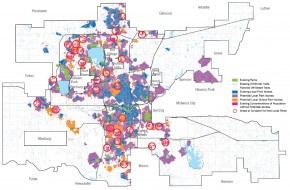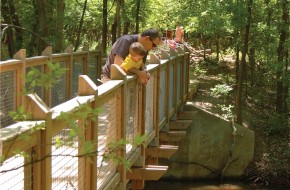Parks Master Plan
The City of Oklahoma City partnered with the Oklahoma City Community Foundation to develop a Parks Master Plan that will guide the City and its partners in creating a parks system that can meet challenges and serve the needs of current and future populations. The plan recommends how the public and private sectors can best develop, promote, utilize, manage, and maintain a fully functional park system.
Plan Strategies
The six strategic directions listed below were synthesized from citizen and stakeholder input. These strategies provide high-level guidance to the City and its partners in establishing new policies and programs, developing new partnerships, and allocating resources to maintain, improve, and leverage the park system for greater community benefit.:
- Maintain and improve physical assets of existing parks.
- Develop facilities and programs in existing parks to meet community needs.
- Improve access to existing parks.
- Promote and increase awareness of the value of parks.
- Develop new parks and facilities.
- Establish agreements and standards for private parks and school parks.
For each of the strategic directions the Parks Master Plan establishes a rationale, a set of actions, and specific steps the City and its partners can take to implement the actions. An action table takes this a step further to assign responsibility for implementation, list potential implementation partners, offer performance measures to gauge success, and suggest a time frame for implementation.
Park Classifications
The Parks Master Plan categorizes parks into three tiers for the purpose of defining levels of service: local parks, regional parks, and other parks.
Each park classification includes a general description, a typical size range, a typical length of visit, access provisions, and a list of appropriate amenities for that type of park based on best practices and community input. The appropriate amenities for any individual park should be determined through a regular park master planning process that involves the community it is meant to serve.
Level of Service Standards
Oklahoma City’s park system has not grown uniformly as the city has grown. As a result, different areas of the city have different levels of access to parks. In some parts of the city, residents may be within a five minute walk of a park, while in other areas, residents may not be able to feasibly walk to a park at all.
The level of service tiers in the Parks Master Plan—central city, urban area, urban growth area, and rural area—balance the existing assets of the park system with the locations of existing and projected population. The standards for each tier reflect the location of existing parks and the budgetary constraints of developing new parks to increase service.
Funding Options
In addition to analysis of the physical park system, the process of developing the Parks Master Plan included an analysis of the system’s financial situation. Based on benchmarking conducted for the Plan, Oklahoma City is below the mean compared to peer cities on per capita spending for maintenance, operations, full-time employees, and spending per full-time employee. Like the City of Oklahoma City government as a whole, the Parks and Recreation Department is impacted by the fact that Oklahoma is the only state in which municipalities do not have access to property taxes for operating expenditures, creating a strong reliance on sales taxes, which are more erratic than other funding mechanisms. This fiscal reality highlights the need for diversified funding sources if the Parks and Recreation Department is to meet its mission of providing high-quality parks, recreational, and cultural services to Oklahoma City residents and visitors as the city grows.
Illustrative scenarios for the Parks and Recreation Department budget were developed to test the levels of funding that will be required to meet current and future levels of service for Oklahoma City over a 20-year time horizon.
- Scenario A: levels of funding continue unchanged.
- Scenario B: incremental increase of five percent per year to allow for additional investment.
- Scenario C: characterizes the level of investment required to address deferred needs and the service needs of present and future residents. Order-of-magnitude cost estimates were used for proposed capital investment, maintenance, and operations and management actions.
The Parks Master Plan offers funding options to supplement funding the Parks and Recreation Department receives from the City’s general fund in order to improve the park system and achieve the strategic directions.
Maintenance Guidelines
The Parks and Recreation Department is responsible for maintaining not just the public parks in Oklahoma City, but also recreation facilities, land next to state highways, and the Civic Center. The Department’s performance measures indicate the City spends very little on park maintenance. Typically, urban park districts in the Midwest spend 2–3 times as much as Oklahoma City does to maintain their parks.
Partnerships
The Parks Master Plan includes recommendations for partnerships. In earlier decades, some cities were fully responsible for the operation of their parks, and they had funding commensurate with the job. Today that is rare, and most cities need the extra assistance of public-private and public-public partnerships to help with the task. These partnerships should never supplant the leadership and the preeminence of the Parks and Recreation Department, but they can help make the difference between a park system that struggles and one that excels. The continued success of Oklahoma City’s park system cannot be solely the responsibility of the City, but instead will rely on the City working hand-in-hand with a robust network of partners.

























